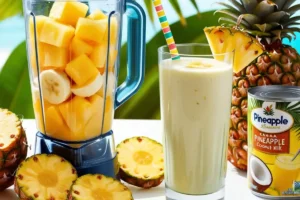Can I Use Canned Pineapple Instead of Fresh? Pros, Cons, and Tips
Understanding Pineapple Varieties
Pineapples are incredibly versatile, whether you’re enjoying them as a snack, baking them into desserts, or using them in savory dishes. To understand whether canned pineapple can replace fresh, let’s first dive into the different types available and how they’re processed.
Fresh Pineapple: Bursting with Natural Flavor
Fresh pineapples are harvested at peak ripeness to preserve their natural sweetness and rich flavor. They have a firm, fibrous texture that many find irresistible, especially when sliced into juicy rings or diced into chunks. Available in most grocery stores, fresh pineapple often requires peeling, coring, and slicing—a bit of work, but worth it for the taste.
Canned Pineapple: Convenience in a Can
Canned pineapple is a popular alternative to fresh, thanks to its convenience. Pre-sliced and preserved in either syrup, juice, or water, it’s ready to use straight from the can. However, the preservation process slightly alters its flavor, typically making it sweeter and softer. While it lacks the crispness of fresh pineapple, it’s a lifesaver for quick recipes.
Frozen and Dried Pineapple: Other Options
Don’t overlook frozen or dried pineapple! Frozen pineapple maintains more of its natural texture and flavor than canned, though it may lack the immediate sweetness. Dried pineapple, on the other hand, works well as a chewy, sugary snack but is rarely a good substitute for fresh or canned in recipes.
For more on preserving pineapple and its nutritional benefits, check out this detailed guide from Healthline.
Sensory and Culinary Aspects
How Flavor and Texture Vary: Fresh Pineapple vs. Canned
When it comes to flavor and texture, fresh pineapple and canned pineapple are like two sides of the same tropical coin. Fresh pineapple boasts a bright, tangy flavor with a firm, almost crunchy texture. Its natural sweetness is balanced by a slightly tart edge, making it ideal for snacking or adding a burst of freshness to dishes.
On the other hand, canned pineapple is preserved in syrup, juice, or water, which significantly impacts its taste and texture. The canning process softens the fruit, giving it a mushier, more tender consistency. While some people love the extra sweetness, others may find it lacks the vibrant tang of fresh pineapple.
The syrup or juice in canned pineapple also adds a sugary punch, which can be both a pro and a con. For sweet recipes, it’s a dream come true. But for savory dishes, it might need balancing with spices or acidic ingredients. Ultimately, both options have their own charm, depending on how you plan to use them.
Creative Ways to Use Canned Pineapple in Cooking and Baking
Whether you’re baking a decadent dessert, whipping up a savory dish, or simply enjoying pineapple as a snack, each type serves a unique purpose.
Baking: Sweetness in Every Bite
Canned pineapple is a baker’s best friend. Its soft texture and syrupy sweetness make it ideal for recipes like pineapple upside-down cake, tarts, and muffins. The consistency ensures that the fruit blends seamlessly with batters, providing moisture and flavor without altering the bake. If you’re short on time, canned pineapple chunks or crushed varieties work wonders in pies or cobblers.
Cooking: Adding Zing to Savory Dishes
Both fresh and canned pineapple shine in savory recipes, but they excel in different ways. Fresh pineapple, with its firmer texture and tangier taste, is perfect for dishes like stir-fries, where it can hold up to high heat without losing its shape. It’s also the top choice for grilling, as the natural sugars caramelize beautifully without becoming overly sweet.
Meanwhile, canned pineapple brings a touch of sweetness to slow-cooked dishes, such as pineapple chicken or glazed ham. The softer texture melts into sauces, making it an excellent base for marinades or sweet-and-sour combinations.
Raw Consumption: Snack or Salad Star
When it comes to eating pineapple raw, fresh pineapple takes the crown. Its juicy, crisp bites are refreshing and energizing, making it a favorite for fruit platters and tropical salads. While canned pineapple can also be eaten straight from the tin, it’s often a little too sweet for salads unless paired with tart or bitter ingredients like greens or citrus.
Each type of pineapple has its strengths, but the choice ultimately depends on your recipe and flavor goals. Whether you’re baking a sweet treat or spicing up a savory dish, both fresh and canned options bring their unique flair to the table.
Health, Cost, and Environmental Factors
| Nutrient | Fresh Pineapple | Canned Pineapple (in Juice) |
|---|---|---|
| Calories | 50 | 60 |
| Sugar | 9.9g | 13g |
| Vitamin C | 47.8mg (80% DV) | 12mg (20% DV) |
| Fiber | 1.4g | 0.9g |
| Manganese | 0.9mg (45% DV) | 0.6mg (30% DV) |
| Bromelain | Present | Reduced or Absent |
Comparing the Health Benefits of Fresh Pineapple and Canned
When deciding between fresh pineapple and canned pineapple, health considerations can play a pivotal role. While both provide essential nutrients like vitamin C, manganese, and dietary fiber, their differences in processing can impact overall health benefits.
Fresh pineapple is a natural source of bromelain, an enzyme known for its anti-inflammatory and digestive properties. This enzyme is sensitive to heat, so canned pineapple—often exposed to high temperatures during processing—may contain less bromelain.
Canned pineapple, especially when packed in heavy syrup, contains added sugars that can contribute to increased calorie intake. Consuming it in moderation is key, particularly for those managing conditions like diabetes or trying to reduce sugar consumption. However, opting for canned pineapple in juice or water can mitigate these concerns.
Allergies to pineapple are rare but can occur. Interestingly, some individuals find fresh pineapple more irritating to the mouth due to its higher bromelain content. For such people, canned pineapple may be a gentler alternative. Yet, always check labels for additives or preservatives in canned products to avoid potential allergens.
Affordable Options: Fresh vs. Canned Pineapple for Everyday Use
When it comes to cost, canned pineapple is often the more budget-friendly option. Its long shelf life and stable pricing make it accessible year-round, even in regions where fresh pineapples are scarce or expensive due to transportation costs.
Fresh pineapple, on the other hand, tends to fluctuate in price depending on the season and location. While its vibrant taste may justify the cost for some, others may find canned pineapple a more practical choice for regular use.
Availability also leans in favor of canned pineapple. While fresh pineapples can be hard to find ripe and ready in colder climates or off-seasons, canned pineapple ensures a consistent supply for consumers worldwide.
Sustainability Insights: Is Fresh or Canned Pineapple Better for the Planet?
The environmental impact of choosing fresh versus canned pineapple isn’t as straightforward as it seems. Fresh pineapples, particularly those imported from tropical regions, come with a notable carbon footprint due to transportation. The shipping process often requires refrigeration, adding to energy consumption.
Canned pineapple, however, introduces its own challenges. The production and disposal of cans contribute to packaging waste. While recycling initiatives help mitigate this issue, the energy-intensive canning process still leaves a significant footprint.
From a sustainability perspective, locally sourced fresh pineapple is the best option when available. But in areas where fresh produce must be imported, canned pineapple may offer a more environmentally friendly alternative, especially when choosing brands that prioritize eco-conscious packaging.
Both options have their pros and cons, and striking a balance between environmental impact, health, and cost can help you make an informed choice.
Practical Usage and Recipes
Storing Pineapple: Fresh vs. Canned Shelf Life
One of the biggest advantages of canned pineapple is its long shelf life. You can store unopened cans for 18–24 months in a cool, dry pantry, making them a reliable option for keeping a versatile ingredient on hand. After opening, transfer canned pineapple to an airtight container and refrigerate it, where it will last for up to a week.
Fresh pineapple, in contrast, is much more perishable. It typically lasts 3–5 days at room temperature or about a week when refrigerated—if uncut. Once peeled and sliced, it should be consumed within 2–3 days for the best taste and quality. Fresh pineapple also requires more effort to store properly, as its outer skin and crown need to be removed, unlike the ready-to-eat convenience of canned pineapple.
For those who need a quick, no-fuss option, canned pineapple offers unmatched ease in storage while reducing waste from unused fresh produce.
How to Replace Fresh Pineapple with Canned in Your Favorite Recipes
Replacing fresh pineapple with canned pineapple in recipes is often a seamless process, but a few adjustments are necessary to achieve the best results.
Measurement Equivalents:
Canned pineapple is pre-sliced into rings, chunks, or crushed forms, so it’s easy to measure out portions. As a rule of thumb, one medium fresh pineapple yields about 5 cups of chunks or rings, which equals approximately two 20-ounce cans of drained pineapple.
Syrup Adjustments:
When using canned pineapple, the syrup or juice it’s packed in can affect your recipe. For baking, the added liquid can enhance moisture, but it’s essential to account for this in your measurements to avoid overly wet batters. If substituting in savory recipes, draining the syrup is advisable to prevent excess sweetness.
Balancing Sweetness in Savory Dishes:
Canned pineapple can be sweeter than fresh, particularly when preserved in syrup. To counteract this in savory dishes like stir-fries or grilled recipes, add tangy or acidic ingredients such as vinegar, lime juice, or soy sauce. This helps balance the flavors without overwhelming the dish.
Popular Dishes You Can Make with Canned Pineapple
Canned pineapple shines in countless recipes, lending its sweet and tangy flavor to desserts, main courses, and even beverages. Here are some classic ideas:
Desserts: Sweet Indulgence
- Pineapple Upside-Down Cake: A timeless dessert that uses canned pineapple rings as the star, caramelized to golden perfection.
- Tarts and Cobblers: Crushed pineapple adds a juicy, tropical twist to these baked favorites.
- Fruit Salads: Combine canned pineapple chunks with fresh berries, melons, and a touch of lime juice for a refreshing dish.
Main Courses: Savory Twists
- Pineapple Chicken: Slow-cooked or stir-fried, canned pineapple adds sweetness to tender chicken pieces, paired perfectly with soy sauce and ginger.
- Ham Glazes: The natural sweetness of canned pineapple syrup is a perfect match for glazing roasted ham.
- Pizza Toppings: Love it or hate it, canned pineapple chunks are a staple for Hawaiian-style pizzas, where they contrast beautifully with salty ingredients like ham or chicken.
Beverages: Tropical Refreshment
- Tropical Smoothies: Blend canned pineapple chunks with coconut milk, banana, and a splash of orange juice for a taste of the tropics.
- Punches: Add crushed canned pineapple to fruit punches for a hint of sweetness and tang.
- Non-Alcoholic Pina Colada: Mix canned pineapple with coconut cream and ice for a creamy, family-friendly drink.
With these practical uses and recipe ideas, canned pineapple proves its worth as a versatile, accessible, and delicious ingredient for any meal or occasion.
FAQs and Conclusion
Answers to Common Questions About Fresh and Canned Pineapple
Can I use canned pineapple in place of fresh in smoothies?
Yes, canned pineapple works wonderfully in smoothies. It blends smoothly due to its soft texture and adds natural sweetness. However, if you prefer a tangier taste or a slightly thicker consistency, fresh pineapple may be a better choice. For a healthier option, use pineapple canned in juice rather than syrup to avoid excess sugar.
Does canned pineapple have the same health benefits as fresh?
While both fresh and canned pineapple provide vitamin C, manganese, and fiber, fresh pineapple contains higher levels of bromelain, an enzyme beneficial for digestion and reducing inflammation. The canning process, which involves heat, can diminish bromelain and some heat-sensitive vitamins like vitamin C. Nevertheless, canned pineapple remains a nutritious and convenient option.
How does the canning process affect pineapple’s nutrients?
Canning involves heat, which may reduce some nutrient levels, particularly vitamin C and bromelain. However, minerals like manganese remain largely unaffected. Pineapple canned in juice retains more of its natural nutrients compared to those in syrup.
Is canned pineapple suitable for grilling?
Yes, canned pineapple can be grilled, though it may not caramelize as well as fresh pineapple due to its softer texture and higher moisture content. Draining and patting the slices dry before grilling helps achieve better results.
Can canned pineapple be used in gelatin desserts?
Absolutely! Unlike fresh pineapple, which contains bromelain that can prevent gelatin from setting, canned pineapple is heat-treated, making it perfect for use in gelatin-based recipes.
How to reduce the sweetness of canned pineapple in savory dishes?
To balance the sweetness, drain the syrup thoroughly and pair the pineapple with acidic or salty ingredients like soy sauce, vinegar, or citrus juice. This contrast enhances the dish’s overall flavor profile.



